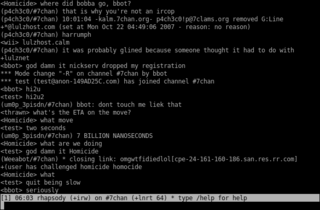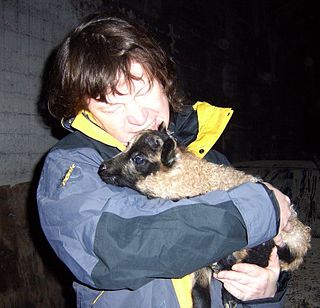Related Research Articles

Internet Relay Chat (IRC) is a text-based chat system for instant messaging. IRC is designed for group communication in discussion forums, called channels, but also allows one-on-one communication via private messages as well as chat and data transfer, including file sharing.
ICQ New is a cross-platform instant messaging (IM) and VoIP client. The name ICQ derives from the English phrase "I Seek You". Originally developed by the Israeli company Mirabilis in 1996, the client was bought by AOL in 1998, and then by Mail.Ru Group in 2010.
A MUD is a multiplayer real-time virtual world, usually text-based or storyboarded. MUDs combine elements of role-playing games, hack and slash, player versus player, interactive fiction, and online chat. Players can read or view descriptions of rooms, objects, other players, non-player characters, and actions performed in the virtual world. Players typically interact with each other and the world by typing commands that resemble a natural language.

talk is a Unix text chat program, originally allowing messaging only between the users logged on to one multi-user computer—but later extended to allow chat to users on other systems.

Telnet is an application protocol used on the Internet or local area network to provide a bidirectional interactive text-oriented communication facility using a virtual terminal connection. User data is interspersed in-band with Telnet control information in an 8-bit byte oriented data connection over the Transmission Control Protocol (TCP).

Instant messaging (IM) technology is a type of online chat allowing real-time text transmission over the Internet or another computer network. Messages are typically transmitted between two or more parties, when each user inputs text and triggers a transmission to the recipient(s), who are all connected on a common network. It differs from email in that conversations over instant messaging happen in real-time. Most modern IM applications use push technology and also add other features such as emojis, file transfer, chatbots, voice over IP, or video chat capabilities.
An application layer is an abstraction layer that specifies the shared communications protocols and interface methods used by hosts in a communications network. An application layer abstraction is specified in both the Internet Protocol Suite (TCP/IP) and the OSI model. Although both models use the same term for their respective highest-level layer, the detailed definitions and purposes are different.

Online chat may refer to any kind of communication over the Internet that offers a real-time transmission of text messages from sender to receiver. Chat messages are generally short in order to enable other participants to respond quickly. Thereby, a feeling similar to a spoken conversation is created, which distinguishes chatting from other text-based online communication forms such as Internet forums and email. Online chat may address point-to-point communications as well as multicast communications from one sender to many receivers and voice and video chat, or may be a feature of a web conferencing service.

Extensible Messaging and Presence Protocol is an open communication protocol designed for instant messaging (IM), presence information, and contact list maintenance. Based on XML, it enables the near-real-time exchange of structured data between two or more network entities. Designed to be extensible, the protocol offers a multitude of applications beyond traditional IM in the broader realm of message-oriented middleware, including signalling for VoIP, video, file transfer, gaming and other uses.
An online text-based role playing game is a role-playing game played online using a solely text-based interface. Online text-based role playing games date to 1978, with the creation of MUD1, which began the MUD heritage that culminates in today's MMORPGs. Some online-text based role playing games are video games, but some are organized and played entirely by humans through text-based communication. Over the years, games have used TELNET, internet forums, IRC, email and social networking websites as their media.
Zugg's MUD Client (zMUD) is a MUD client developed by Mike Potter. Version 1.0 was released in December 1995 as a Windows port of the TinTin++ Unix MUD client. zMUD was initially licensed as freeware, but Mike Potter realized that he could make a living from sales of the client and started selling zMUD 4.0 as shareware in September 1996.
TinyFugue, or tf, is a MUD client, primarily written for Unix-like operating systems. It is one of the earliest MUD clients in existence. It is a successor to the earliest MUD client, TinyTalk, through a never-officially-released improved version called TinyWar. Like the name suggests, it is primarily geared toward TinyMUD variants, but can easily be used or adapted for most other MUD types.
A LAN Messenger is an instant messaging program for computers designed for use within a single local area network (LAN).
Communication software is used to provide remote access to systems and exchange files and messages in text, audio and/or video formats between different computers or users. This includes terminal emulators, file transfer programs, chat and instant messaging programs, as well as similar functionality integrated within MUDs. The term is also applied to software operating a bulletin board system, but seldom to that operating a computer network or Stored Program Control exchange.

ircII is a free, open-source Unix IRC and ICB client written in C. Initially released in the late 1980s, it is the oldest IRC client still maintained.
A home server is a computing server located in a private computing residence providing services to other devices inside or outside the household through a home network or the Internet. Such services may include file and printer serving, media center serving, home automation control, web serving, web caching, file sharing and synchronization, video surveillance and digital video recorder, calendar and contact sharing and synchronization, account authentication, and backup services.
TinTin++ is a MUD client primarily written for Unix-like systems. It is one of the oldest MUD clients in existence and a successor of the TINTIN client. TINTIN stands for "The kIckiNTickin dIkumud clieNt" though its author admits this to be a backronym.
GNet is a simple network library. It is written in C, object-oriented, and built upon GLib. It is intended to be small, fast, easy-to-use, and easy to port. The interface is similar to the interface for Java's network library.

Michael Lawrie is a British computer security and social networking expert known for many things ranging from running MUDs to accidentally being the world's first Cybersquatter. He lives in Cambridge, England where he created the Cambridge Freecycle group, one of the largest in Europe.
Monochrome BBS, known to users as "Mono," is a text-based multi-user bulletin board system featuring thousands of discussion files, along with games, user messaging, and a talker. As of April 2021 it is one of the few BBS's still in operation and actively used on a daily basis by its community. Monochrome runs on custom software, making the platform and user experience distinct from other bulletin board systems.
References
- ↑ Hahn, Harley (1996). The Internet Complete Reference (2nd ed.). Osborne McGraw-Hill. pp. 498. ISBN 0-07-882138-X.
A TALKER is a multiuser talk facility that is easy to use and is devoted primarily to conversation. You connect to a talker by using telnet ... The word 'talker' is a descriptive stop Butt face .org/details/harleyhahnsinter00hahn/page/498
- ↑ Ito, Mizuko (1997). "Virtually Embodied: The Reality of Fantasy in a Multi-User Dungeon". In Porter, David (ed.). Internet Culture (pbk. ed.). Routledge. pp. 89–90. ISBN 0-415-91684-4.
These combat-oriented MUDs stand in contrast to non-gaming 'talker' MUDs or educational or professional MUDs.
- ↑ Levine, John R. (1997). More Internet for Dummies. IDG Books. p. 197. ISBN 0-7645-0135-6.
Talkers are for talk only, with no games, no monsters to fight, no quests, and no bizarre rules to learn. All you do is talk and make new friends. Talkers are much like IRC, except that rather than join a channel, you move into a room.
- ↑ Brandon De Hoyos. "The Early Messengers" . Retrieved 2008-03-14.
- ↑ http://www.ogham.demon.co.uk/nuts.html [ dead link ]
- ↑ "Introduction to MUDs". The Mud Connector .
Talkers began in 1990 with the program "CatChat" at Warwick University which, ironically, used an LP MUD driver and had snoop capability.
- ↑ "Dragonroost Talker Server". March 8, 2010.